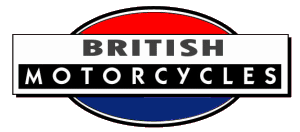

Herbert Bert Hopwood (born 1908) was a British motorcycle designer. He helped with some of the most influential designs for the British motorcycle industry and worked for Ariel, Norton, BSA and Triumph.
Bert left school at an early age to work for Ariel under designer Val Page. Following Jack Sangster's purchase of Triumph in 1936 he moved there under Edward Turner and was influential in the development of the Triumph Speed Twin, a design which became a landmark in the history of motorcycling.
His success led to an offer from rival manufacturer Norton in April 1947 where he designed the Norton Dominator engine. This came to a somewhat acrimonious end when the Technical Director refused to release the complete machine for production, despite Norton's financial situation. This was based on the allegation that the engine lacked power and the performance was below par as a result.[2] It was subsequently produced with no alterations to the engine, after Hopwood had left the company.
Hopwood handed in his notice to the Norton Board in December 1948 and joined BSA in May 1949. BSA purchased Triumph in 1951.
April 1955 found him at Norton once more, still with Gilbert Smith as MD, but now under the aegis of AMC at Woolwich. When Smith retired in 1958 he and the financial director at Bracebridge Street, Alec Skinner, were allowed to get on with taking this part of AMC forward with much improved results, together with Doug Hele as Chief Engineer. Sadly their efforts were to no avail, as the parent company was in a situation which absorbed all the modest profits made by Norton and Francis-Barnett, the only really profitable members.
Hopwood was recruited by Edward Turner in May 1961 to become his successor. This did not eventuate, but he did become Triumph Director and General Manager.
Well-known machines he designed include the Norton Dominator, BSA A10 and the BSA Rocket 3/Triumph Trident.
Sources: Graces Guide, Phil Hannam, et al.
25th July 2023
pnh at talktalk dot net
Dear British Motorcycles
I have spotted a couple of errors in the Bert Hopwood autobiography which I feel you need to be aware of.
If you read Hopwood's own book.....Whatever Happened To The British Motorcycle Industry?' the first point that I mention below will largely be substantiated.
1) In May 1948 he joined BSA, which in 1951 purchased Triumph. Hopwood handed in his notice to the Norton Board in December 1948 and did not join BSA until May 1949.
2) It (The Dominator Engine) was subsequently produced with no alterations to the engine, after Hopwood had left the company. There were serious problems with Hopwood's design that included issues with both the casting and machining of the cylinder head. It lacked power and quickly over-heated when run at speed. This, in turn, causing carburettor and hot engine starting problems. The inlet tracts of the original Hopwood cylinder head had to be completely redesigned. As Hopwood had left Bracebridge the redesign work was carried out by Jack Moore who had shared a small drawing office with Hopwood for the previous 18 months.
In 1945, Jack Moore had been asked to design an engine to compete with the Triumph 500 post-war. He eventually came up with two prototype engines. One being a shaft-driven engine mounted in a modified Norton 16H frame. His second design was more conventional with a chain driven rear wheel. This engine was destined to go into production during 1948 mounted in a modified ES2 frame. However, Hopwood arrived in 1947 and decided that Moore's engine was too complex to produce economically, leaked oil and also looked too similar to the Triumph twin. It also having it twin camshafts with front and rear pushrod tubes, gear driven timing wheels and detachable rocker boxes. Apart from the cylinder head, Hopwood's design was easier and cheaper to manufacture and almost oil tight.
However, the Moore design was not wasted as modified variations of his crankshaft, conrods, pistons, timing cover and oil pump were incorporated in the Model 7 engine. Other features of the Moore design were also later used in the Jubilee and Navigator engines over a decade later.
Trust the above makes sense. Please feel free to get back to me if you need to ask questions. Details of the Jack Moore prototypes can be found through various search engines.
Sincerely
Phil Hannam
Surrey Norton Owners Club
If you have further information or a query related to this page, please contact us